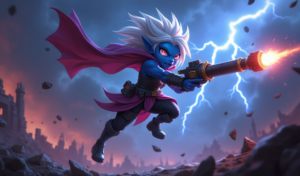Overview
Effective warding strategies in League of Legends provide critical information advantage through seven key techniques: strategic lane placement, objective control, deep jungle tracking, vision denial, support roaming, phase adaptation, and team coordination. These comprehensive approaches to vision control not only prevent ganks and secure objectives but also enable proactive plays, with statistics showing teams that establish superior vision control win approximately 65% of matches across all ranks.
Table of Contents
Introduction to Warding Strategies in League
Mastering warding strategies in League of Legends often separates good players from great ones. In a game where information equals power, effective vision control can be the deciding factor between victory and defeat. This comprehensive guide explores seven proven warding strategies League players use to dominate the Rift across all ranks.
Vision control isn’t just about placing random wards—it’s a sophisticated tactical element that requires understanding of game timing, map pressure, and objective control. Whether you’re a support main shouldering the vision burden or any other role contributing to team sight, these techniques will elevate your gameplay.
From Bronze to Challenger, implementing these warding strategies consistently will help you track enemy movements, secure objectives, and make informed decisions that lead to more wins. Let’s illuminate the path to victory by mastering the art of vision control.
The Importance of Vision Control
Before diving into specific warding strategies in League, it’s essential to understand why vision control matters so much. Vision provides crucial information that directly impacts decision-making across all phases of the game.
First, proper warding prevents ganks and ambushes, significantly reducing your death count and maintaining lane pressure. Furthermore, vision around objectives like Dragon and Baron creates opportunities for steals or contest plays that can swing game momentum in your favor.
Beyond safety, vision enables proactive plays. With information about enemy positions, your team can improve map awareness and make calculated rotations, catch isolated opponents, or secure objectives without opposition. According to Riot Games’ own statistics, teams with superior vision control win approximately 65% of matches at all ranks.
Finally, vision denial is just as important as vision provision. By clearing enemy wards and controlling neutral areas with strategic vision, you force opponents to face the dreaded “fog of war” – making them play reactively rather than proactively.

Technique 1: Strategic Ward Placement for Lane Dominance
The foundation of effective warding strategies in League begins with mastering lane-phase ward placement. During this critical early game period, placing wards that protect you while providing valuable information can secure your lane advantage.
For bottom lane players, the tri-bush and river entrance are priority warding spots. These locations provide advance warning of jungler movements and potential roams from mid. Top laners should focus on river bush and the enemy jungle entrance nearest to their lane to prevent ganks.
Mid laners face threats from all directions, making their warding strategy slightly more complex. Alternating wards between both river entrances provides basic protection, while more advanced players should improve vision timing with deeper wards based on the enemy jungler’s likely path.
Here are key lane warding locations by role:
- Top: River bush, enemy blue/red buff entrance, herald pit when active
- Mid: Both river entrances, raptor camp for jungle tracking
- Bottom: Tri-bush, river entrance, dragon pit entrance when objective is spawning
- Support: Defensive river wards early, transitioning to objective control
- Jungle: Enemy buff entrances, scuttle areas, invade wards at camps
Remember to adjust placement based on whether you’re pushing or being pushed. When ahead, ward deeper to enable aggression; when behind, ward defensively to prevent dives and create safe farming zones.
Technique 2: Objective Control Warding
Objective control forms the backbone of winning warding strategies in League. Properly timing your vision around Dragons, Rift Herald, and Baron Nashor gives your team significant advantages in securing these game-changing objectives.
Start by establishing vision approximately 60 seconds before an objective spawns. This timing allows your team to clear enemy wards, set up ambushes, and control the approach paths. For Dragon, place wards both inside the pit and in the surrounding jungle entrances to spot enemy rotations.
Control wards play a crucial role in objective vision. Place them in bushes adjacent to the objective rather than directly in the pit. This forces enemies to venture deeper into dangerous territory if they want to clear your vision.
Advanced objective warding includes:
- For Dragon: Ward the pit, enemy jungle entrance, and mid-river bush
- For Herald/Baron: Ward the pit, both jungle entrances, and the pixel bush
- For late-game Elder Dragon: Deep wards in enemy jungle to track team movements
Remember that objective control requires team coordination. As a jungler, communicate your pathing to ensure your team has vision established before you attempt a secure. Support players should save charges on their warding item for these crucial objective fights rather than using all charges in lane.
According to data from professional play, teams that establish vision control around objectives 45+ seconds before spawn have nearly 70% higher objective secure rates than those who set up late.
Technique 3: Deep Warding for Jungle Tracking
Deep warding is an advanced warding strategy in League that provides invaluable information about enemy jungler movements. By placing wards at key camps like buffs, gromp, or raptors, you can track clear patterns and anticipate ganks with remarkable accuracy.
The best time to place deep wards is when you have lane priority, allowing for a safe venture into enemy territory. Alternatively, support players and junglers can coordinate roaming opportunities to establish this crucial vision network.
For maximum effectiveness, learn the optimal deep ward spots:
- Between enemy Raptors and Red Buff for central jungle vision
- Behind Blue Buff wall to track that quadrant
- The crossroads between Wolves and Blue Buff
- The brush connecting mid lane to the jungle
Deep warding has cascading benefits beyond jungle tracking. It enables your laners to play more aggressively when they know the enemy jungler’s position. It also provides opportunities for your own jungler to make counter-plays, stealing camps or setting up invades.
According to ProGuides analysis, players who consistently deep ward and track enemy junglers climb ranks 15% faster than those who rely solely on lane warding.
Remember that deep warding carries risk, so assess the game state before attempting it. When behind, focus on defensive vision rather than risky deep wards that could result in additional deaths.
Technique 4: Vision Denial with Control Wards
Vision denial is a critical component of advanced warding strategies in League. Control wards (pink wards) are your primary tool for clearing enemy vision and creating darkened zones where your team can make unpredictable plays.
Unlike regular stealth wards, control wards reveal and disable enemy wards in their radius, making them essential for objective control and ambush setups. Every player should purchase control wards throughout the game, not just supports.
Here are key locations for effective control ward placement:
- Pixel brushes in both rivers for mid-game control
- The small brush near red buff for jungle entrance control
- Tri-brush for lane phase defensive vision
- Baron/Dragon pit adjacent brushes (not in the pit itself)
To maximize control ward value, place them in locations that are both useful for your team and difficult for enemies to clear safely. The ideal control ward might stay active for 5+ minutes while continuously denying enemy vision.
An important aspect of vision denial is timing your control ward placements with strategic macro objectives. Place control wards 60-90 seconds before objective spawns to begin clearing enemy vision early, giving your team information advantage when it matters most.
Remember that control wards don’t hide themselves – they’re visible to enemies. This makes them excellent bait tools as well. Sometimes placing a control ward in a contested area can lure enemies into unfavorable positions where your team can collapse.

Technique 5: Support Roaming Ward Strategies
Support players carry the primary responsibility for implementing warding strategies in League, especially during roaming phases. Effective support warding combines vision establishment with map movement to create opportunities across the map.
The most successful support players time their ward placements with roaming opportunities. After shoving a wave with your ADC or after recalling, use these windows to establish vision in key areas while looking for gank opportunities on mid or with your jungler.
When roaming to ward, follow these principles:
- Move with your jungler when possible for safety
- Ward objectives based on their spawn timers
- Establish vision lines that protect multiple lanes simultaneously
- Clear vision with sweeper before placing new wards
Support warding evolves throughout the game. Early game focuses on lane safety and river control, mid-game shifts to objective setup and jungle entrances, while late game demands baron/elder vision and deep wards for pick potential.
Remember that as a support, your Warding Totem should be upgraded to a Support Item as soon as possible. This provides additional ward charges and eventually enables Control Ward placement. Always maintain at least one Control Ward in inventory for crucial objective fights.
Finally, communicate your warding movements to prevent your ADC from overextending while you’re gone. The phrase “warding bot river” gives critical information that allows your carry to play accordingly during your brief absence.
Technique 6: Adaptive Warding Throughout Game Phases
Effective warding strategies in League require adapting your approach as the game progresses through different phases. What works in the early game won’t necessarily provide value in the mid and late game.
During the early laning phase (1-14 minutes), focus on defensive wards that prevent ganks and track the enemy jungler. River entrances, tri-bushes, and pixel brushes provide essential information while requiring minimal risk to place.
As the mid-game approaches (15-25 minutes), transition to objective-focused warding. This includes deeper river control, buff entrance wards, and vision around neutral objectives like Dragon and Herald. Junglers should coordinate with supports to establish these vision lines.
In the late game (25+ minutes), warding becomes increasingly dangerous but even more critical. Key areas include:
- Baron and Elder Dragon approaches
- Enemy jungle quadrants
- Flanking positions around major objectives
- Brushes along likely rotation paths
The most successful teams improve macro play by adjusting ward density based on the game state. When ahead, place aggressive wards that enable picks and objective control. When behind, establish defensive vision networks that prevent further advantage for enemies.
Remember that ward limits mean quality over quantity. One perfectly placed ward that spots a key rotation is worth more than three suboptimal wards that provide minimal information.
Technique 7: Team Coordination for Vision Control
The most advanced warding strategy in League involves coordinating your entire team’s vision efforts. When all five players contribute to a cohesive vision plan, your team’s information advantage becomes overwhelming.
Start by clearly communicating vision goals in chat or voice comms. Simple callouts like “warding dragon in 1 min” or “need vision top side for herald” help align your team’s focus. Everyone should understand their role in the vision game.
Create vision control by moving as a unit when establishing deep wards. A support and jungler duo can safely place deeper wards than either could alone. Meanwhile, laners should time their back timings to purchase control wards for crucial objectives.
The most effective team vision strategies include:
- Coordinated sweeping of enemy vision before objectives
- Rotating ward coverage as objectives change
- Protecting key wards from being cleared
- Sharing vision responsibilities across all roles
Even in solo queue, you can improve team vision by pinging your warding intentions and requesting assistance when needed. A simple “need help warding baron” can make the difference between a blind face-check and a safe vision setup.
According to analysis from professional play, teams with coordinated vision plans secure 23% more neutral objectives than teams with disjointed vision approaches. This statistic emphasizes how critical team-based vision control is to victory.
Conclusion
Mastering these seven warding strategies in League of Legends will significantly elevate your gameplay and increase your win rate. Vision control remains one of the most underutilized tools at lower ranks, making it a powerful way to gain advantages over opponents who neglect this aspect of the game.
Remember that effective vision isn’t just about quantity but quality and timing. Strategic ward placement, objective control, jungle tracking, vision denial, support roaming, adaptive warding, and team coordination form a comprehensive approach to dominating the vision game.
Implementing even a few of these warding strategies will yield noticeable improvements in your decision-making and game outcomes. The players who consistently apply these principles climb ranks faster and contribute more to their team’s success, regardless of their main role.
Make vision control a priority in your gameplay, purchase control wards regularly, and communicate with your team about vision objectives. With practice, these habits will become second nature, illuminating your path to victory on the Rift.
Frequently Asked Questions
Where should I place wards early game?
Early game wards should prioritize river entrances, tri-bushes, and pixel brushes to protect against ganks and track the enemy jungler’s movements. Adjust based on which side of the map the enemy jungler likely started.
How many control wards should I buy per game?
Most high-ranked players purchase 4-7 control wards per game, with supports buying 7-12. Always keep at least one control ward in your inventory throughout the mid and late game for objective control.
When should I switch to Oracle Lens (Red Trinket)?
Junglers should switch to Oracle Lens after their first back, supports after completing their ward quest item, and other roles when transitioning to mid-game or when playing against stealth champions. Vision denial becomes increasingly important as the game progresses.
How do I ward effectively when my team is behind?
When behind, focus on defensive warding around your remaining structures, jungle entrances, and potential ambush points. Move as a group when establishing vision, and use blue trinkets for long-range scouting to avoid face-checking dangerous areas.
Is warding the responsibility of supports only?
No, effective vision control requires all team members to contribute. While supports have more ward capacity through their items, every role should purchase control wards and use trinkets strategically throughout the game to maximize map coverage.




